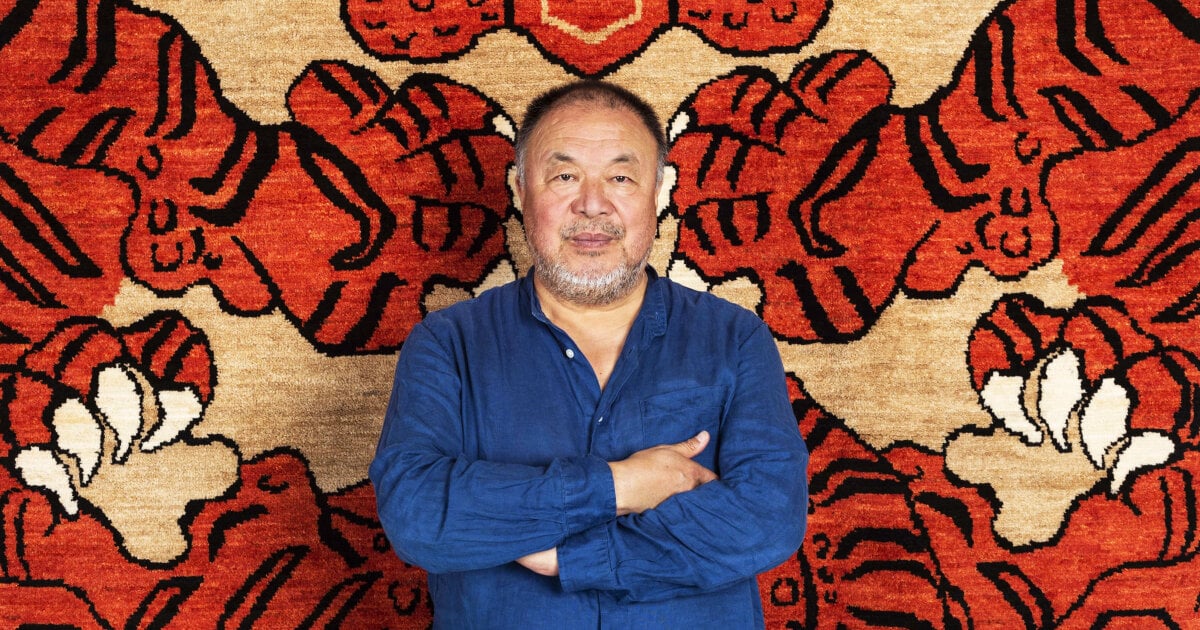Tibetan tiger rug of ai weiwei
Ai Weiwei has long been intrigued by the relationship between humans and animals. These living beings usurp the time Weiwei could have invested in rather mundane tasks and nudges him to invest his effort in detailed research that taps into his passion for documentation and marks his ever-expanding oeuvre. In one of his moments, the Tibetan rugs and the theme of tigers came up, and Weiwei has since then latched onto the idea of materializing them in real life one day. That day has finally come. With ‘Tyger,’ Weiwei spins and weaves his Tibetan- and tiger-inspired vision into a hand-knotted, hand-spun, and hand-dyed natural Ghazni wool rug.
Tyger (2022) by Ai Weiwei forms part of the exhibition ‘Tomorrow’s Tigers’ in Sotheby’s London, a featured project of the World Wildlife Fund for Art For Your World in 2022. It aims to raise funds for and awareness of tiger conservation coinciding with this year’s Lunar Year of the Tiger and marking the culmination of the global commitment to double the number of wild tigers by the end of 2022. Curated by Artwise and produced by Christopher Farr, Weiwei and other invited artists, including Anish Kapoor, have been asked to design a rug in response to tiger conservation. When Weiwei received the invitation from WWF to design a tiger rug for the project, he did not think twice and snapped up the opportunity to voice his advocacy, one that is dear to him.
images courtesy of Art For Your World | photos by Thierry Bal
Ai Weiwei reflects on the design of his tiger rug
Ai Weiwei took his time contemplating what design would go into his rug. He might have revisited his anecdotes in the past, rifling through the digital and physical pages where he jotted down his observations and activism or re-reading philosophical and scientific findings about the essence of tigers and the data regarding its decline in population. Time finished passing with him holing up in his own space, and Weiwei opened his doors to his viewers for the outcome he invested his time in. Gracing ‘Tyger’, the traditional colors of orange for the body, white for the claws and details, and black for the animal print appear evident in Weiwei’s design.
Instead of letting the tiger pad through a forest or between growing bamboo, Weiwei flattens his tiger on the rug. He stretches the animal in a counter-clockwise manner, seemingly concealing what the tiger is going through from behind as the viewers could only see what is happening up front. Its head lies on the upper part of the canvas while its tail splats on the bottom. The look of the tiger resembles a dragon’s face, the one often depicted in the Chinese New Year celebration. Since the event overlaps with this year’s Lunar Year of the Tiger, the artist might have drawn some of his influences from this joyous well. There is space at the center of the beige-colored carpet for the formation of an X shape, perhaps an urgent call to the viewers to take action and somewhat a foreshadowing of what might happen if tiger preservation becomes unresponded.
Ai Weiwei has long been intrigued by the relationship between humans and animals
Tolerance and understanding are rare to find
Ai Weiwei believes that human civilization can only be measured by looking at how human beings treat and form a bond with other living beings, animals included. As written on the Art For Your World page, Weiwei notes that this concept looms over people’s tolerance and understanding towards other species and the well-being of all life. The way people interact with living beings might denote the depth of their respect for themselves and how much they value what life and Earth have given them.
‘As a matter of fact, this kind of tolerance and understanding are very rare and difficult to find. Through the rug design, I hope to be able to do something for tigers; the meaning of their existence surpasses the scope of our comprehension, and yet 95% of tigers in the wild have gone extinct over the last 100 years, very sadly,’ says Ai Weiwei in the quote in Art For Your World.
Weiwei reminds the viewers that protecting endangered animals is a kind of self-love, ‘without which we would all be living in a savage land.’ Along with him, the artists who will present their made-to-order rugs include Francesco Clemente, Peter Doig, Bernard Frize, Gary Hume, Reena Saini Kallat, Maya Lin, Harland Miller, Raqib Shaw, Kiki Smith, and Rose Wylie. The rugs will be exhibited this autumn at Sotheby’s, London from November 24th to 29th and available to buy online.
Tyger (2022) by Ai Weiwei forms part of the exhibition ‘tomorrow’s tigers’
the exhibition aims to raise funds for and awareness of tiger conservation
the project aims to the commitment of doubling the number of wild tigers by the end of 2022
